Disclosure: Some posts contain affiliate links, which earn us a commission if you make a purchase through them. Positive Fishing © participates in various affiliate networks including the Amazon Services LLC Associates Program.
Fishing with dry fishing flies is an amazing experience and it’s a must-do for any passionate fly angler.
There’s a moment in every fly angler’s career that hooked them on the sport of fishing. For many, it’s the first opportunity they had to fish a hatch. The massive amount of activity and hungry fish during this period can make for over an hour of nonstop action.
Using Dry flies to directly match the hatch isn’t always easy, but once you do, you’ll have as many fish as you can handle.
In this article, I will cover:
- What is a Dry Fly?
- What Fish Eat Dry Flies?
- When Should I Use a Dry Fly?
- How do I Fish with Dry Flies in Moving Water?
- Look for Rises
- Always Be Ready
- Keep Things High and Dry
- Cast Upstream of a Strike
- How do I Fish with Dry Flies in Still Water?
- Be Delicate
- Locate the Fish
- Best Dry Flies
- Popper
- Chubby Chernobyl
- Elk Hair Caddis
- Parachute Adams
- Sparkle Dun
What is a Dry Fishing Fly?
Dry flies are often a representation of adult insects. They sit directly on the surface of the water so anglers can always see where their fly is. Whether it’s a terrestrial insect or a Caddis pattern, you’ll most commonly find dry flies as representations of insects that hatch and live their lives around water.
Dry flies can also be a representation of larger prey. For example, mice are a common food for fish and companies create mice patterns for anglers to use. Another common dry fly option for fly anglers to use is poppers. These move quite a bit of water and are great options for anyone looking to land bass on the surface.
If you are wanting to target fish on the surface at any point during your fishing excursion, you’re going to be using a dry fly.
What Fish Eat Dry Flies?
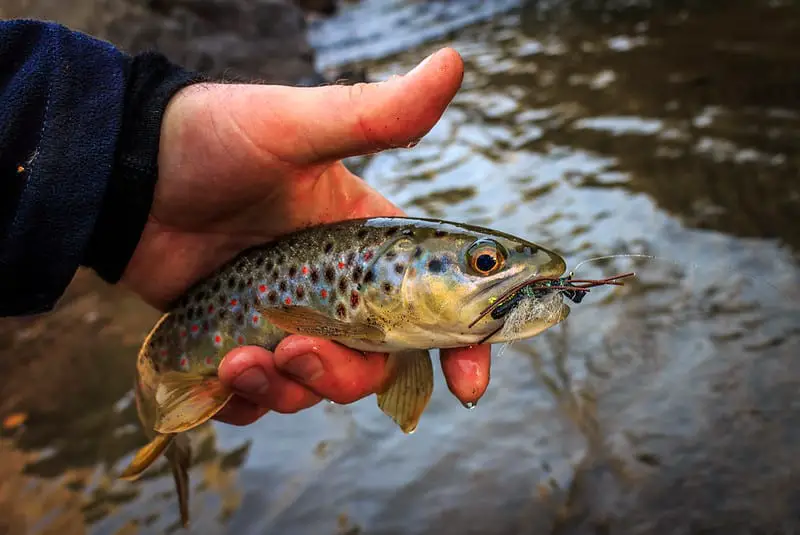
Most fish are willing to feed at all levels of the water column. Depending on the time of day and the time of year, you’ll find certain fish to be more willing than others to eat on top of the water.
The primary fish that are going to eat dry flies on the surface of the water are trout, bass, and pike. All are willing to eat on the surface, but require different conditions to do so.
You’ll also find that bluegill, carp, salmon, and even steelhead will feed on the surface, but this is a little less productive. These fish primarily do their feeding below the surface of the water.
The general rule of thumb with dry fly fishing is that if you see something feeding on the surface, do your best to figure out what it is and start casting!
If you are looking for some more detailed information on matching the hatch and how to read hatch charts, please take a look at my article here!
When Should I Use a Dry Fly?
For trout, they’ll wait until a hatch is occurring to start looking at the surface of the water. Hatches often occur during the first sunlight of the morning and right at sunset in the evening. You can identify a hatch when you start seeing insects flying in groups right above the surface of the water.
They’re also easy to identify when you start seeing all sorts of ripples on the surface of the water. Fish start feeding on the surface and this will often continue for 30 minutes to an hour. If you can time it right, you’re in for a treat.
Bass and pike don’t look to eat insects. They’re looking for larger prey like frogs, mice, and birds. They’ll eat on the surface at all times of the day, but you have to make sure the location you have chosen is a quality environment for these animals to be on the surface.
Topwater fishing close to shore, near reeds and lily pads as well as any underwater structure is going to be the most productive. Don’t randomly throw dry flies in all parts of the water. Be selective and choose to fish where you know some predators may be hiding.
You may not see any topwater action with bass and pike, but that doesn’t mean you can’t throw dry flies. These fish are always waiting to find a good meal.
You can learn more about the best fly types to choose and when to use them here!
How To Fish with A Dry Fly in Fast-Moving Water?
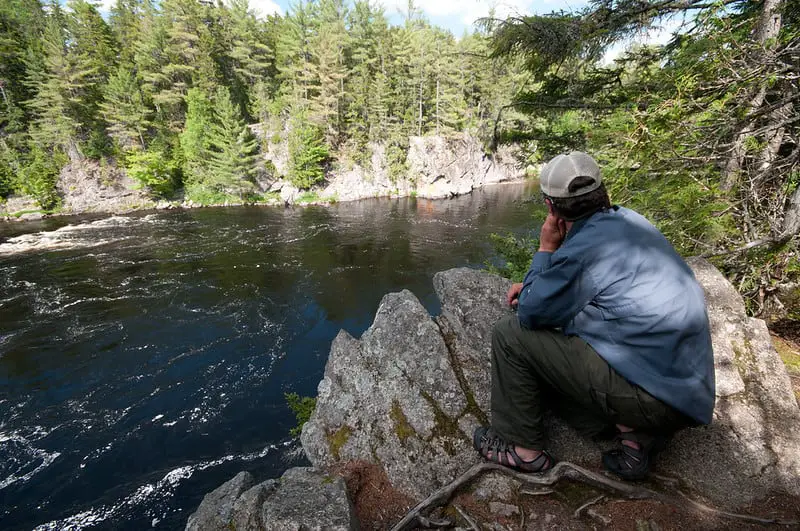
Thankfully, fish, especially trout, make your decision on whether or not to use a dry fly extremely easy. Either the fish are feeding on the surface or they’re not. Again, bass and pike don’t always let you know when they’re feeding on the surface, but the potential is always there.
Look for Rises
In the world of fishing, the word “rise” is one that’ll speed up an angler’s heart rate. A rise is when a fish breaks the surface to feed. You’ll see the rings start spreading out and you’ll know it’s time to start throwing the dry flies.
You don’t have to get overly creative with where you throw dry flies. If you see a rise, throw it there. If you don’t see a rise, don’t throw it there. It’s not uncommon for fish to miss a fly the first time so if you cast where you just saw a fish rise, then they’ll go in for a second swoop and grab your fly. Don’t overcomplicate things!
Always Be Ready for a Strike
In dry fly fishing, things move fast. You are likely not going to be waiting very long for a strike. As soon as your fly hits the water, be ready for a fish to pounce. Within 10 seconds, you’re likely going to have a fish take your fly. If you don’t get a take, consider recasting and putting your fly near a different rise.
Since fish are in a feeding mood, you don’t want to waste too much time if a certain spot on the water isn’t producing. These windows don’t last too long, so give a spot a couple of casts and then move to a different rise in a separate section of the water.
Keep Things High and Dry
Dry flies aren’t completely waterproof. The more casts you make, the more water your fly is going to absorb. When your dry flies absorb water, they’re going to sit lower on the surface of the water and may even fall under the surface. This defeats the purpose of dry flies. You want to make sure your flies are high on the surface so you can see them and they look as realistic as possible.
To keep your flies dry, you’re going to need to purchase a dry fly floatant. Floatant is something that absorbs water and can make your flies even more waterproof than normal. You can pick up a bottle of floatant at your local fly shop or in most online fishing retailers. It’ll help you catch even more fish.
Cast Upstream of a Strike
When you see a rise, cast upstream of it. If you cast below it, you’ll likely miss the fish. Just like you would cast the majority of your other flies upstream, do the same with your dries. Let the dry fly float right past the mouth of the fish. If you do this, your fly will have more of an opportunity to appear natural. You’ll have a chance to mend or strip to make sure everything looks accurate before the fly is next to your fish.
How To Fish with Dry Fly On A Lake Or Still Water?
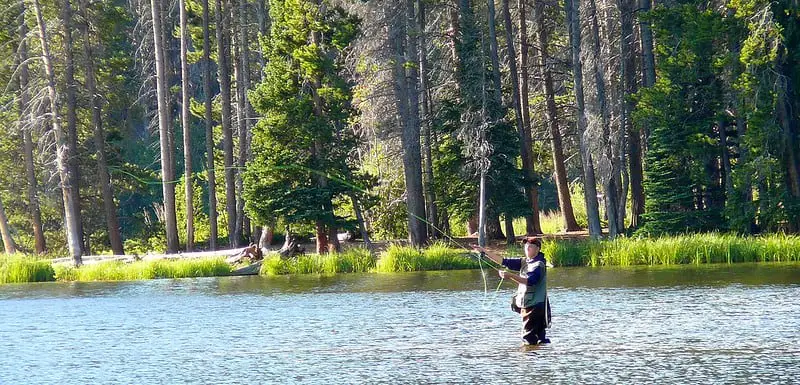
Casting dry flies in still water heightens excitement in anglers. Stripping a dry along still water and waiting for a fish to strike focuses all your senses in preparation for a strike.
Be Delicate with Your Casts
It’s always important to be delicate when you’re fishing with dry flies. Fish are often extremely picky with dry flies because they have more time to analyze these flies. If an aspect of the fly or cast is unnatural, you won’t get bites. This is even more true in still water.
If you follow through too hard on your cast, your fly will hit the water and spook the fish. You want your fly line to unravel and have your dry lay down softly. This won’t spook the fish!
It’s going to take practice to be able to correctly lay down your dry flies, but once you learn the proper methods, you’ll find yourself increasing the chances of landing quite a few more fish.
Do some practicing at a local park or in your backyard before you throw on the water. You don’t even have to tie on a fly when you’re practicing. Your dries weigh next to nothing so it won’t be too much of a difference when you tie one on your line.
Locate the Fish
Similar to fishing dry flies in moving water, you want to find rises. If you’re fishing for trout, this is going to be easy. If a hatch is occurring, you’ll see them all over the water. Cast near one of these and you’ll be in business.
If you’re targeting bass or pike, spend time near structure or weeded areas. This is where things like frogs, mice, and birds are going to sit. You may have to move quite a bit of water with your fly to draw the attention of these fish.
What Are The Best Dry Flies?
There are hundreds of dry fly patterns anglers can use. Depending on where you’re fishing in the world or what type of fish you’re targeting, there’s no shortage of patterns. Thankfully, there are a few patterns that are universal and work for almost any area of the world you want to fish.
Popper
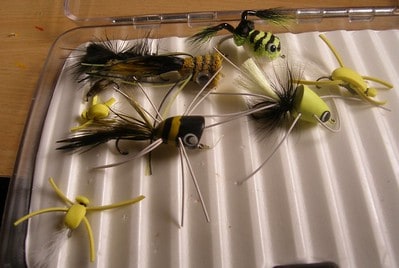
If you’re fishing for bass, purchase poppers. You can fish the popper with short strips that move quite a bit of water. Purchase numerous different colors to make sure you draw the attention of the fish. You’ll find these in sizes 4 to 8.
Chubby Chernobyl
If you’re the type that wants to fish a dry-dropper or you love terrestrial season, the Chubby Chernobyl is a perfect pattern. It represents a variety of insects including beetles and grasshoppers. In the late summer, this pattern is going to work wonders.
Elk Hair Caddis
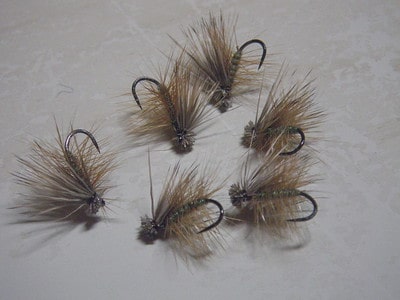
The Elk Hair Caddis pattern is a wonderful, small search pattern. If you see a hatch occurring, but aren’t quite sure what is hitting, tie on an Elk Hair Caddis and see what you can find. You can find this in sizes 14-22.
Parachute Adams
The Parachute Adams is another wonderful searching pattern. It’s a mayfly representation. Mayflies hatch all year round so it’s a great option to have. Purchase it in sizes 16-24.
Sparkle Dun
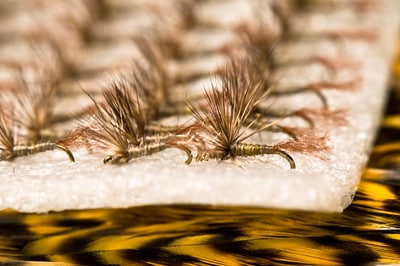
The Sparkle Dun has a bit of flash that you may need on those slower days. If it’s sunny and the water is clear, don’t be afraid to throw this pattern. It’s going to work! Purchase it in sizes 12-20.
Final Thoughts
Fly fishing using dry flies is probably the most common form of catching trout or salmon. The pure excitement when a fish rises to your fly and you strike into a fish!
I hope this article has been an enjoyable read. Always switch things around and try different flies with alternative presentations, not every day is the same. Results change frequently!
You can learn more and find all the specific details about fishing fly types such as streamers and nymphs in my other articles.
- Wading Belt Essentials: Ensuring Safer Fishing - January 9, 2024
- Fishing For Catfish (Top Tips, Bait, & Gear To Catch The Big 3) - October 20, 2022
- Fishing Line Strength Vs. Diameter Chart: Why Is It Important? - October 12, 2022

